#patanjali
Explore tagged Tumblr posts
Text
A psicoterapia é fundamental para quebrar todos os tipos de ciclos mentais que levam ao sofrimento por repetição.

Não é mais necessário se tornar um monge budista e passar anos a fio imerso em praticas meditativas, basta fazer uma boa psicoterapia.

Ciclos mentais fazem com que pessoas fiquem presas a magoas, lembranças e qualquer tipo de ancora que leva a uma cascata de manifestações psicossomáticas, que são as principais causadoras do famoso sofrimento humano tão estudado pelo príncipe Siddhata Gautama o Buda.

Livre-se das âncoras através das psicoterapias.

#psicoterapia#cérebro#mente#psicanálise#terapia#psicossomáticas#meditation#meditação#mindfulness#buda#tao#budismo#taoísmo#hinduismo#yoga#patanjali#paramahamsayogananda#hatthayoga#zen#vajrayana#mahayana#hinayana#theravada#krishna#shivha#babaji
79 notes
·
View notes
Text

Patanjali's Yoga Sutras propound the Astanga Yoga (अष्टांग योग )or Yoga with 8 limbs. It is also referred to as Classical or Traditional Yoga. Patanjali organized the practices of yoga into an "eight-limbed path" Containing the steps and stages towards obtaining Samadhi or enlightenment.
For more Info ℹ
_____________💮
______________🧘🏻♀️
*Manaskriti*
Certified RYT 500 hrs Virginia USA
💻 https://wa.me/916301573258
📨 manaskriti28@gmail.com
📞 Call/WhatsApp 6301573258
📍 *MANASKRITI SCHOOL OF YOGA*
#ManaskritiYoga #ManaskritiOnline
#PatanjaliAYTT #CertificateCourse
#WomenHealth #YogaEducation
#InternationalYoga #Yoga #Ayurveda
#YogaTeacherTraining #RYS200hrs
#YogaTherapy #RYS500hrs
#YogaPractice #YogaFacts #YogaPoses
#YogaMat #YogaPractice
#YogaInspiration #YogaMotivation
https://www.instagram.com/p/DFhA25WKAXE/?igsh=MWJ0NWtwMzZ1bTZ2cw==
#ManaskritiYoga#ManaskritiOnline#yoga#ayurveda#patanjali#socialmedia#ayush#mdniy#naturopathy#ycb#yogacourses#meditation#Spotify
2 notes
·
View notes
Text
A Short Introduction to the Yoga Sutras
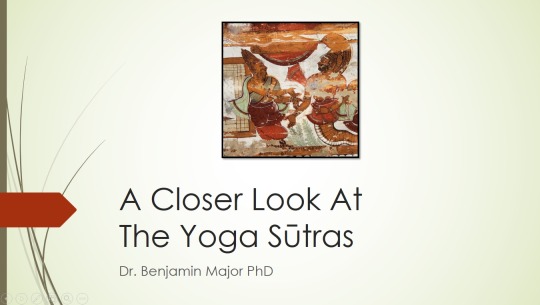
The Yoga Sutras are generally considered a foundational text of the yoga tradition. In this article we examine the context and background of the text, briefly explore its structure and content, and I also offer some reflections on the text’s relevance in modern times.
Note: I have decided not to use diacritics in this article. Diacritics are those little lines and dots above and below letters that tell you how to pronounce Sanskrit words. Normally I use diacritics in my writing, as they are essential for pronouncing Sanskrit correctly. However as this article is meant for non-scholars I have decided it would be better to try and write the Sanskrit words in a way that will make them easy to read and pronounce, so as not to put anybody off!
History & Context
Most scholars these days date the Yoga Sutras to somewhere between the 2nd and 5th centuries CE, with Philipp Maas placing it in the early 5th century.
The text is attributed to a sage named Patanjali. Biographically, we know next to nothing about Patanjali. The name is a compound word formed from the Sanskrit words pata (falling, flying) and anjali (the gesture of joining the hands together in reverence).
Yoga had already been around in some form or another for many centuries by this point. Therefore, Patanjali did not ‘invent’ Yoga. Nevertheless, this is the earliest comprehensive and systematic text on the subject that has survived.
Yoga was just one darshana or school out of many in ancient India. In terms of philosophy, it shares many similarities with the Samkhya school. But whereas Samkhya tends to emphasise the use of reason and knowledge to gain liberation, Yoga emphasises practical and experiential methods.
Philosophically, both the Samkhya and Yoga schools teach a form of dualism. This is a dualism between purusha (our true Self) and prakriti (everything else, including the body and mind) and the whole point of Samkhya and Yoga in a nutshell is to guide us towards the realisation of purusha, that is, our true Self. This is true liberation or moksha in Yoga.
Most of the ancient darshanas had their own sutra text. Sutra texts are known for their brevity. Basically, sutra texts are where the most essential teachings of a school are distilled into as few words as possible. Knowledge systems were handed down orally in ancient India and thus source material was kept minimal with a view to facilitating memorisation.
Other authors would then come along and write longer commentaries on these sutra texts. The Yoga Sutras have a rich commentarial tradition spanning many centuries. The first and most well known is the bhasya commentary by a certain Vyasa. Vyasa actually means something like ‘compiler’ or ‘editor’ so that probably wasn’t his actual name!
Some scholars even argue that Patanjali and Vyasa are actually one and the same person, though others would strongly disagree with this thesis. Either way, this commentary is indispensable when it comes to making sense of the sutras, and published versions of the Yoga Sutras tend to include the bhasya commentary or at least reference it.
As a final note, many scholars now use the term pātañjalayogaśāstra to refer to this text as a whole (sutras plus commentary), because that is the name our oldest existing manuscripts use. But to keep things simple we will continue to use the name Yoga Sutras!
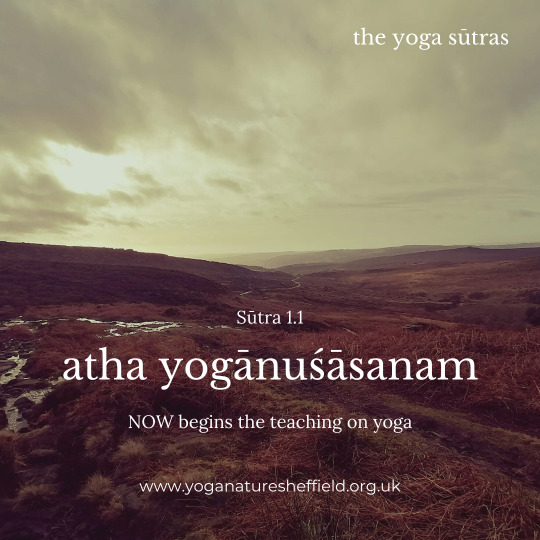
Structure of the Text
The Yoga Sutras are divided into the following four padas or chapters:
Samadhi Pada: This is where Patanjali defines Yoga and then describes the nature and the means to samadhi, the goal of Yoga.
Sadhana Pada: Sadhana is the Sanskrit word for practice or discipline. Here the author outlines two forms of Yoga, the kriya yoga (yoga of action) and the ashtanga yoga (the yoga of eight auxiliaries or limbs). This is also where Patanjali discusses the kleshas, five ‘afflictions’ or impediments to Yoga.
Vibhuti Pada: Vibhuti is the Sanskrit word for power or manifestation. Supra-normal powers (siddhis) are said to be acquired by the practice of Yoga. However, the temptation of these powers should be avoided and the attention should ultimately be fixed only on liberation.
Kaivalya Pada: Kaivalya literally means isolation. This is the chapter on final liberation. The Kaivalya Pada describes the process of liberation, it explains how the mind is constructed and veils the inner light of the Self.
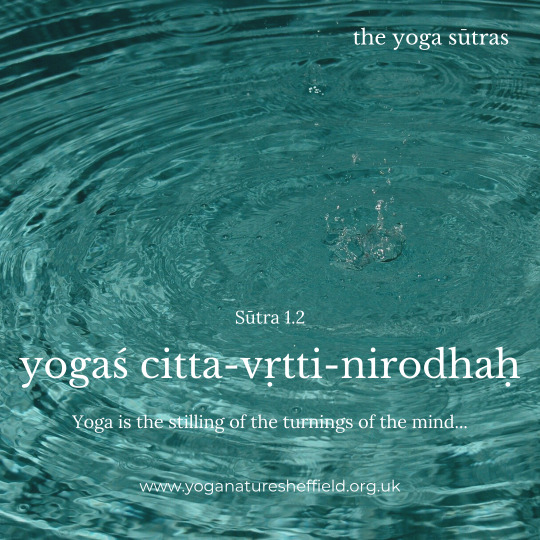
The Goal of Yoga
Not one for a lengthy preamble, Patanjali gets stuck right in there and clearly states the goal of Yoga in the well-known second sutra:
yogas chitta-vritti-nirodhah YS 1.2
Any Sanskrit sentence allows for a number of possible translations and this one is no different. A nice and accurate one is this one from Barbara Stoler Miller:
Yoga is the cessation of the turnings of thought
The reason I say this one is accurate is because a literal meaning of vritti is ‘turning’. Ever felt that thoughts are ‘going round and round’ in your head? Well this phrase nicely captures that! The vrittis in this statement refer to thoughts, emotions, ideas and basically any cognitive act of the mind. Patanjali lists five types of vrittis. These are, once translated:
Right knowledge
Error or false knowledge
Imagination
Sleep &
Memory
All such activities of the mind are products of prakriti and are completely distinct from the true Self, purusha, that pure awareness or consciousness which we are aiming to enter into through Yoga. The means prescribed by Patanjali in the first chapter of the Yoga Sutras to still the vritti states of mind are sustained practice (abhyasa) and dispassion (vairagya).
Specifically the practice offered is meditation, or keeping the mind fixed on any particular object of choice without distraction. Patanjali then describes a number of possible forms such meditation could take. By stilling all thought, meditation removes all objects of awareness. Awareness can therefore now be aware only of itself, of its own source, the true Self or purusha. This state is known as samadhi in Yoga and Patanjali makes it super clear that this state of samadhi is the goal of Yoga and thus the whole text is focused upon achievement of that goal.
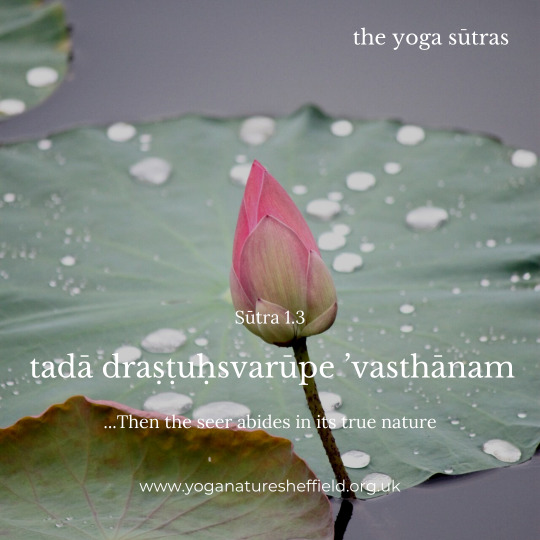
Obstacles to Yoga
Patanjali mentions five kleshas, which can be translated as impediments or obstacles to achieving samadhi and thus Yoga. These five are as follows:
Ignorance
Ego
Desire
Aversion
Clinging
In the Yoga Sutras, and indeed in ancient Indian philosophy in general, the first item in any list is the most important and fundamental. It’s the same here. Ignorance here means failing to recognise our true Self or purusha and instead identifying ourselves with our body, mind and the material world. All of the other obstacles arise from this fundamental error.
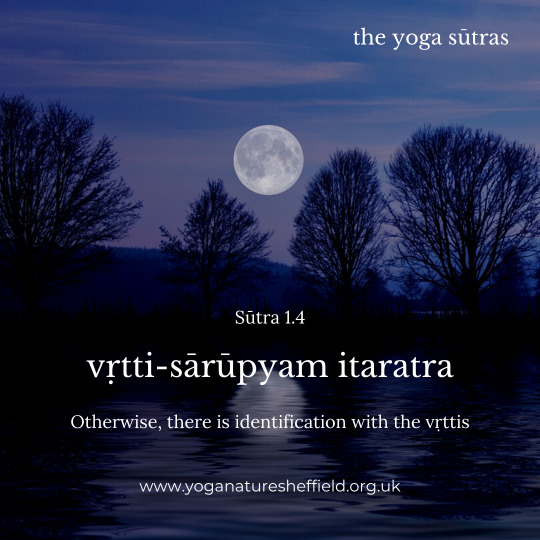
Yoga Psychology
Like most other schools of Indian thought, the Yoga school believed in the related concepts of karma and rebirth. According to this doctrine, we are caught in an endless cycle of rebirths called samsara and the purpose of following a path such as Jainism, Buddhism or Yoga is to bring an end to this cycle. Where the Yoga Sutras really shine are in interpreting this doctrine in a highly sophisticated ‘psychological’ way, to use modern terminology.
According to this Yoga psychology, the mind forms an impression of an object through the sense organs, which is called a pratyaya. Once this pratyaya or active image of this object is no longer of active interest to the mind, it becomes an inactive or latent samskara. A samskara is an imprint left in the chitta, somewhat like a sound is imprinted on a tape recorder, or an image on photographic film. In this way the vrittis, the activities of the mind, are retained as samskaras when they fade.
It is important to note that these samskaras are not just passive imprints but vibrant latent impulses that can get activated under conducive circumstances and can exert influence on a person’s thoughts and behaviours, even many years after the impression was made. What’s more, according to Yoga these samskaras can persist from previous lives. The chitta is thus something of a storehouse of these recorded samskaras, deposited and accumulated there over countless lifetimes. One is here reminded of the theory of the subconscious in modern psychoanalysis.
According to Yoga, karma is generated by the vrittis, and the vrittis, in turn, are produced by the kleshas. There is thus a vicious cycle of kleshas, vrittis and samskaras. To run through the whole cycle again to try and make it as clear as possible: vrittis are recorded in the chitta as samskaras, and these samskaras eventually activate consciously or subliminally, producing further vrittis. These vrittis then provoke actions and reactions, which in turn are recorded as samskaras, and the cycle continues endlessly, leading to much suffering along the way.
The whole Yoga project aims to bring this vicious cycle to an end and it is liberation from this mind created suffering that we are after as yogis. The Yoga Sutras are effectively a manual guiding us towards this end, this state of samadhi or complete meditative consciousness.

The Yamas and Niyamas
The second pada or chapter of the Yoga Sutras contains a famous exposition of five ethical restraints (yamas) and five ethical observances (niyamas) and these are relatively well-known in the modern yoga world. The first thing to get clear is that these yamas and niyamas are NOT original or unique to Yoga. All ascetic schools in ancient India had these ethical codes, and the exact same ones appear in Jainism for example. Sometimes, you even get more of them. Some yoga texts for instance list 10 yamas and 10 niyamas.
The five yamas listed in the Yoga Sutras are:
Ahimsa (non-harming) Satya (truth telling) Asteya (non-stealing) Brahmacharya (chastity or celibacy) Aparigraha (non-acquisitiveness)
The five niyamas are:
Shauca (purity or cleanliness) Santosha (contentment) Tapas (self-discipline) Svadhyaya (study) Ishvarapranidhana (devotion to the Ishvara or Lord)
Many of these could do with further explanation and commentary but there is not space in this present article. The other thing I want to stress is that these yamas and niyamas were not seen as optional extras for yogis. Rather, these were the bedrock of fruitful yoga practice. Patanjali and others refer to them as the mahavratam or ‘great vow’. Importantly, having listed the yamas, Patanjali devotes an entire sutra to reiterating just how central and non-negotiable these yamas are. Once translated, this sutra reads as follows:
[These yamas] are considered the great vow. They are not exempted by one’s class, place, time or circumstance. They are universal. YS 2.31
So, regardless of your social status, regardless of where you live, in which time period you live, and any other extenuating circumstances (such as your career), adherence to the yamas, including especially ahimsa, the foundation of them all, is an essential part of being a yogi as defined by Patanjali’s system.
Vyasa is even more emphatic in his bhasya commentary to the Yoga Sutras, and it is here that the link between ahimsa and vegetarianism is explicitly and unequivocally made, and several examples are brought to bear. Refer to the work of scholar Jonathan Dickstein to read more about the strong case for vegetarianism made in Patanjali Yoga.

The Ashtanga Yoga
These yamas and niyamas are just the first two parts of Patanjali’s famous ashtanga or eight-part path. I would first like to clarify that this systematisation of yoga into a series of angas (a word translated by some modern scholars as ‘auxiliaries’ but more commonly rendered as ‘limbs’) was again not novel to Patanjali. Throughout the yoga tradition we find various similar schemes, predating and postdating Patanjali, including fourfold, fivefold, sevenfold and even fifteenfold schemes. I would also like to stress that, despite sharing the same name, this ashtanga yoga bears little relation to the modern postural form of yoga known as Ashtanga.
Following the yamas and niyamas then, we then have the following six angas:
Asana (posture): At last I hear you cry, postures! In Patanjali’s day meaning a steady and comfortable seated posture, asanas today comprise a set of physical exercises which stretch and strengthen the body. It is this aspect of yoga that has been most visibly exported to the West but too often stripped from its context as just one ingredient in a more ambitious and far-reaching sequence.
Pranayama (breath control): Prana refers to the universal life force whilst ayama means to regulate or control, but it can also mean to expand and lengthen. Prana is the vital energy needed by our physical and subtle layers, without which the body would perish. It is what keeps us alive. Pranayama is thus the control or expansion of prana through the breath, depending on which definition of ayama you use.
Pratyahara (withdrawal of the senses): This limb further deepens the above process by removing consciousness from all engagement with the senses (sight, sound, taste, smell and touch) and sense objects.
This is followed by the final three limbs collectively known as samyama: Dharana (concentration, fixation), Dhyana (meditation), and finally Samadhi (the latter of which Patanjali further divides into seven rather esoteric stages). These last three limbs are essentially different degrees of concentrative intensity and culminate in the realisation by the Self of its own nature.
Just to reiterate one more time, it is this Self-realisation, the state known as samadhi, that is the true goal of Yoga.

Relevance of the Yoga Sutras for Today
In this brief introduction we have of course only scratched the surface of this incredible text, and there is much more that could be said. But for now I want to end with some concluding reflections on the continuing relevance of the Yoga Sutras in the modern world.
One question that arises is whether Patanjali was prescribing a strictly ascetic path. And indeed, the general scholarly consensus has usually been to associate Patanjali's Yoga exclusively with extreme asceticism, mortification, denial and renunciation. However, there are dissenting vocies. For example, Ian Whicher has repeatedly and passionately argued that Patanjali's Yoga can be seen as enabling a more responsible living in and engagement with the world, and that Patanjali was not advocating total renunciation. For Whicher, following the path of Patanjali can lead one towards that integrated and embodied state of liberated selfhood whilst living, a state known as jivanmukti.
Regardless of whether Patanjali was historically preaching ascetism or not, the fact remains that the Yoga Sutras are full of valuable ideals and tools for the practitioner living in the modern world. Let’s face it though, this is a challenging path. As a scholar and practitioner I often perceive a huge disconnect between the kind of yoga I am seeing on the likes of Instagram and the teachings of the Yoga school as presented in the Yoga Sutras. After, all, the former is highly focused on body image, whereas the Yoga of Patanjali is all about dissociating ourselves from our body and mind and recognising our true Self. However, this does not mean that the two are necessarily irreconcilable.
Though there is absolutely no historical evidence that Patanjali and his followers were practicing postural yoga (that didn’t come until later with the emergence of the Hatha tradition) nowhere in the Yoga Sutras does it say that physical exercise cannot be part of one’s yoga practice. We just have to remember that as far as Patanjalian Yoga is concerned, such postural activity is just a further means or method on the path towards samadhi or full meditative awareness. This is why any so-called yoga that does not contain more internalised meditational practices but which focuses solely on physical exercise should not really be called yoga.
The Yoga Sutras remains undoubtedly the most famous ancient yoga text, and it is studied to some extent in probably every yoga teacher training course. To be honest, I personally feel that too much emphasis is placed on the Yoga Sutras, at the expense of other branches and other texts of the tradition. The Tantric texts, in particular, are still sorely neglected. One of my own aims in my work is to try and decentre the Yoga Sutras and provide a much wider overview of the history and philosophy of yoga and the other related schools of ancient India. This is not to take anything away from the Yoga Sutras, however, as it is without doubt an extraordinary text that continues to be highly relevant in the 21st century.
Further Reading
I have already mentioned some scholars whose work you may wish to refer to, such as Philipp André Maas, Ian Whicher and Barbara Stoler Miller. For a translation and commentary on the Yoga Sutras that is both scholarly accurate and reasonably accessible I would recommend that of Edwin Bryant published by North Point Press.
12 notes
·
View notes
Text
PARAMAHANSA YOGANANDA BIRTH CHART ANALYSIS


Let's look into the chart of a very wise man, a Yogi from India known as Paramahansa Yogananda (original name is Mukunda Lal Ghosh), a spiritual teacher who popularized the practice of Kriya Yoga all over the world. He is known as "the father of meditation in the west".
His book "Autobiography of a Yogi" gained huge popularity, to the extent that after George Harrison from The Beatles read the book, Yogananda was featured on the cover of the album "Sgt. Pepper's Lonely Hearts Club Band". Steve Jobs also has read this book several times.
Virgo rising, Mercury in Sagittarius, the sign of spirituality, in the 4th house of home and parents. His parents were spiritual, they practiced Kriya Yoga, and they were disciples of Lahiri Mahasaya, a great Guru who taught a whole line of teachers. This definitely means that he came from a spiritual home, he had a spiritual upbringing which shared his life direction. Sagittarius is the sign of Travel also. And Mercury is about transportation. His family moved around a lot when he was a child bc his father worked in a large Indian railway company.
His moon is in the 12th house. This can show a deep bond with the mother and sometimes loss of the mother figure in one way or another. Paramahansa Yogananda was deeply affected when his mother passed away during his childhood, then the Divine Mother appeared to him in a vision and told him that She is the one who was taking care of him all along. The 12th house is also about foreign lands. He had great success abroad in the USA where he founded an institution to initiate disciples into the practice of Kriya Yoga and teach them. In year 1925 he founded The International Center for the Self Realization Fellowship in Los Angeles,California,which is near his sun-ascendant line & Uranus-midheaven line in astrocartography. He was meant to "shine" there & get recognition (sun-asc line) & he got sudden success(Uranus-Mc line).
His Ascendant and moon, according to Vedic astrology, fall in the Lunar Mansion called Magha. This is the Lunar Mansion or Pitris (ancestors). People with this lunar mansion honor their forefathers. They don't have to be related by bIood though! Paramahansa Yogananda chose his own ancestors who are the line of Kriya Yoga masters and teachers: Mahavatar Babaji, Lahiri Mahasaya, and Swami Sri Yukteswar Giri who was Yogananda's teacher. He followed and honored ancient wisdom. Also if you're one of those who believe that Nakshatras have a planetary lord then Magha is ruled by Ketu (the South Node) which purifies the shallowness of material life, this shows detachment from the material realm and a tendency towards austerity.
This is what the 2nd century astrologer Vettius Valens says in "Anthologies - Book I" about the bound of Yogananda's Ascendant, the Mercury bound of Virgo :" lofty, procurational, an arranger, handsome, organizing great affairs, most intelligent, entirely noble and eminent..". I think it describes him accurately. Also the fact that his asc is in the bound of Mercury contributed to the immense success of his autobiographical book (Mercury is writing and books). The 12th part of Mercury is also on his Ascendant. His natal Mercury is actually debilitated. This is a proof that debilitation isn't the end of the world. His book sold four million copies.
His out of sect malefic is saturn is in the 2nd house of wealth. He was not interested in wealth and making money which caused his family- especially his older brother - to criticize him a lot. He was only interested in what transcends the material world which we live in.
He met his teacher Swami Sri Yukteswar Giri when he was 17 years old in 1910, and he was in a level 2 peak period when releasing from the Lot of Spirit. In 1915 when he was 22 he formally took his monastic vows, which was in another level 2 peak period. In 1917 he founded a school in India for young boys which teaches Yoga and spirituality, which was another level 2 peak period, but now under level 1 Gemini period, and Gemini rules schools and education. In the pre-LB period, in 1924, he was on a successful tour in the USA. In 1925, he was in a level 2 peak period and that was when he established the Self Realization Fellowship in California.
He has his 1h ruler Mercury conjunct his benefic of sect Venus cause he has a night chart. Venus rules his 9h which is all about gurus and teachers so the best thing in his life is his guru and teacher Swami Sri Yukteswar Giri. Yukteswar had a stellium in Taurus (Sun, Mercury, Mars and the North Node), and they all fall into Yogananda's 9h of teachers. Nice fact: Yukteswar was an astrologer.
Yogananda composed a lot of spiritual music ("Cosmic chants"), he has Mercury-Venus conjunction which imo gives musicians and musical abilities. I am not using asteroids much nowadays but I couldn't ignore his chiron conjunct Ascendant: it's clear in his book that since he was a child he realized that he was not like other people, that he was connected to the spiritual world which shallow people didn't even pay attention to, that he didn't desire to get a high position, accumulate wealth, get married, have children etc ... he didn't care about all that,he desired a union with the divine and that was his desire only. In a much corrupted world back in his days as it is now,his teachings brought inner peace to people. In this way he is a healer, & he devoted his life not to personal material ambition but to a higher purpose.
#Paramahansa#paramahansa yogananda#mukunda lal ghosh#magha#magha nakshatra#Nakshatras#self realization#self realization fellowship#yogoda satsanga society#yogoda#yss yogananda#the beatles#steve jobs#vedic astrology#Yukteswar#swami sri Yukteswar giri#astrology#california#zodiac#kriya yoga#patanjali yoga sutras#patanjali#zodiac signs#astro#horoscope#astrología#vedic astro#nakshatra#nakshatras#magha moon
6 notes
·
View notes
Text

divination
* * * *
Patanjali, in his classic work on yoga, formulates in his first sentence the practical and theoretical essence of yoga—the “first arcanum” or the key of yoga—as follows: Yoga citta vritti nirodha (Yoga is the suppression of the oscillations of the mental substance, Yoga Sutras 1.2) —or, in other terms, the art of concentration. For the “oscillations” (vritti) of the “mental substance” (citta) take place automatically. This automatism in the movements of thought and imagination is the opposite of concentration. Now, concentration is only possible in a condition of calm and silence, at the expense of the automatism of thought and imagination.
[Meditations on the Tarot: A Journey into Christian Hermeticism
by Valentin Tomberg]
#divination#Patanjali#Meditations on the Tarot: A Journey into Christian Hermeticism#Valentin Tomberg#yoga#the mind#quotes
46 notes
·
View notes
Text
Verse 3: The Mirror of True Knowledge — Insights from Ramana Maharshi
“Having known the Self, which is awareness, there is nothing more to know. That which is, is consciousness itself. To seek it elsewhere is to wander far away.”— Ramana Maharshi, Forty Verses on Reality There comes a moment in each of our lives when the questions that have followed us, haunting our thoughts, cease to carry the same weight. It is as though we have been wandering through a vast…
#abiding in awareness#awakening#awareness#contemplation#discipline of yoga#effortless effort#Forty Verses on Reality#Indian philosophy#Inner peace#Letting Go#liberation#meditation#Mindfulness#non-duality#Patanjali#personal growth#pristine mind#Ramana Maharshi#self-inquiry#Self-Realization#spiritual journey#Spiritual Practice#Spiritual teachings#surrender#Timeless Wisdom#Vedanta#wu-wei
2 notes
·
View notes
Text
Book of the Day - Yoga Sutras of Patanjali
Today’s Book of the Day is Yoga Sutras, written by Patanjali around the 2nd century BCE. Patanjali – पतञ्जलि, also called Gonardiya or Gonikaputra, was a Hindu author, mystic, and philosopher, who was believed to be a Siddhar, an enlightened scholar of Yoga and spiritual knowledge. He lived between the 2nd and 4th centuries CE. I have chosen this book because people often ask me which kind of…

View On WordPress
#Asana#Ashtanga#Ashtanga Yoga#Dharana#Dhyana#Eight Limbs#Kaivalya#meditation#Niyama#Patanjali#Patanjali&039;s Ashtanga Yoga#Prakṛti#Pranayama#Purusha#Raffaello Palandri#Raffaello Palandri Yoga#Samadhi#Tantra#Yama#Yoga#Yoga Sutra
34 notes
·
View notes
Text
YOGA is the discipline (art & science) of being fully present in the moment we are experiencing right NOW.
~ Vimal sharma

https://yogasutra195.com/sutra-1-1/
#yoga philosophy#sprituality#mindfulness#psychology#meditation#awarness#conciousness#yoga sutra#yoga sutras#patanjali#power of now#self awareness
3 notes
·
View notes
Text
Now the politicians, yoga teachers and so called yogis have reduced the great system of yoga to only 'asanas' and 'pranayam.
Yoga according to Patanjali is a compact and complete discipline having eight steps. It starts with 'yama' (self-restraint) and completes with 'samadhi' (trance, ecstasy) - (1) yama (self-restraint), (2) niyama (fixed observance) (3), asan (relaxed posture), (4) pranayam (breath regulation), (5) pratyahar (abstraction, turning back), (6) dharna (concentration), (7) dhyan (meditation, state of no thoughts) and (8) samadhi (trance, ecstasy) Asanas and pranayam are only third and fourth steps. These eight steps are to be practised from beginning to the end and not arbitrarily.
Osho
6 notes
·
View notes
Text


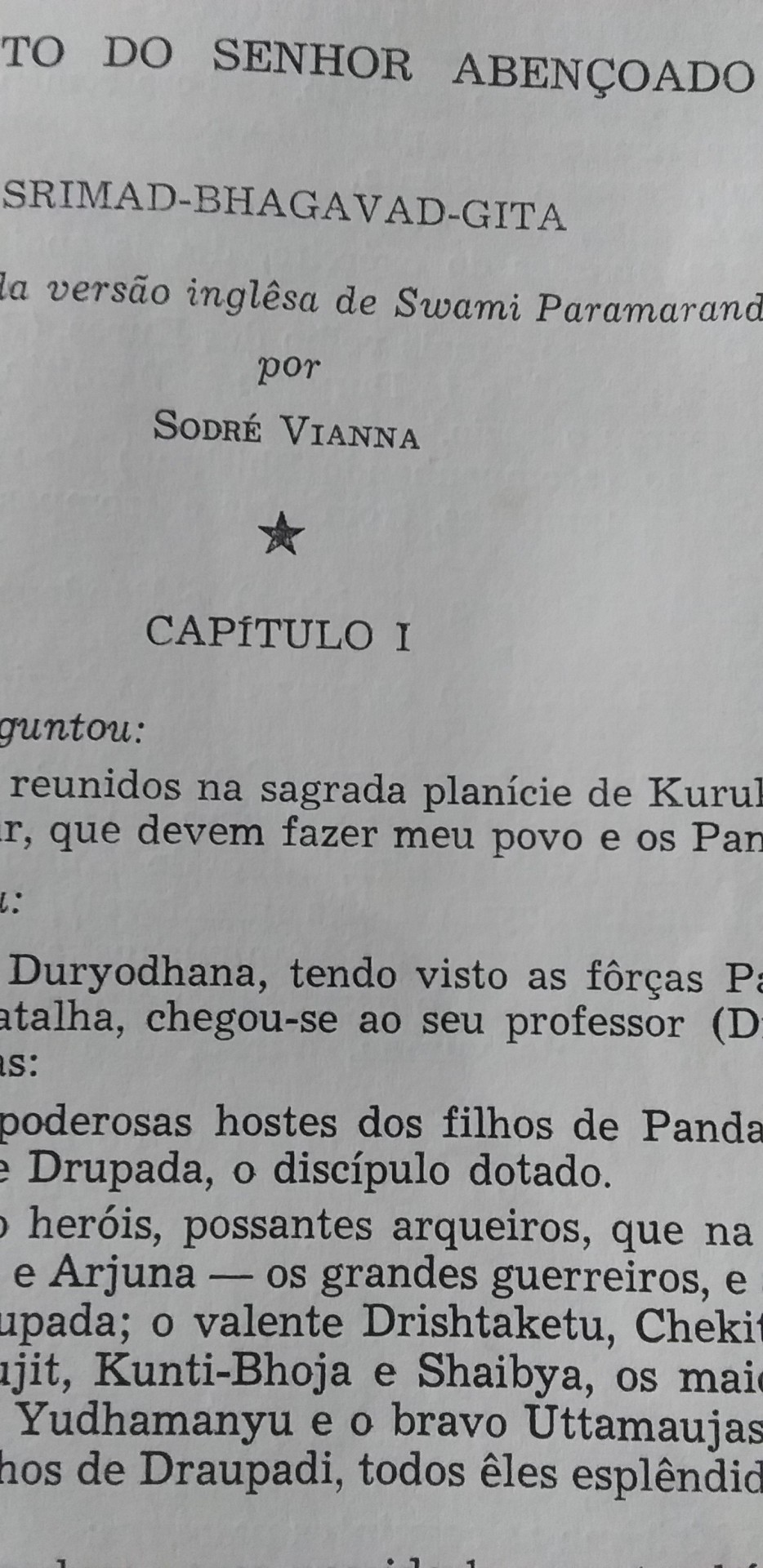


5 notes
·
View notes
Text
Yoga è la cessazione delle fluttuazioni della mente.
Patanjali
6 notes
·
View notes
Text
purusha and prakriti
In an age long since past, where time and space danced the eternal waltz of existence, nestled in a cosmos teeming with celestial expanse, was a tiny planet. This was Earth, a planet known for its extraordinary vigor, beauty, and lush life. It was here Prakriti danced - a wonder of creation, the material cosmos personified.
Prakriti, in all her grandeur, was the Seen, an enigmatic entity of braided pulsars, clustered galaxies, and swirling neon nebulae. She was the ocean's depth and the mountain's height, she was both the raging tornado and the softest snowflake. Her dance was the seasons and the stars, life and death, creation and decay. In her cosmic ballet, she was everything - and yet, unseen.
Who could appreciate her infinite dance, her celestial choreography? Her cosmic prevalence was too sacred and subtle to be understood by the untrained eye, and thus, unperceived she remained, dancing through the cosmic maelstrom, yearning a worthy observer.
Then there came Purusha, the Seer. He was unlike any other, an entity rare and trustworthy who came from the silence that existed between thought and action. Removing the veils of ignorance and illusions, he sought to comprehend the profound dance of Prakriti, the cosmic spectacle that lay before his transcendental sight.
Purusha watched, and as he did, he realized his fortunate position. Before him danced the Universe, her beauty unparalleled, her dance dazzling. His gaze was unwavering, his reverence sincere. He silently vowed to honor the dance, to see it not with mortal eyes but with a pure, unblemished soul.
The dance of Prakriti continued, flowing through galaxies and echoing through time. And Purusha, with devoted admiration, beheld the dance, a rare and worthy audience. A sacred bond formed between the Seen and the Seer, a communion as old as time itself.
And thus, the dance of the cosmos continued, observed by the Seer, through him acquiring value and through him being understood. But it was also through the Seen that the Seer found his purpose. Theirs was a dance of mutual existence, a dance of unity.
In the end, Purusha and Prakriti together unveiled a cosmic truth: the dance of the cosmos indeed exists, ever-vibrant and divine, but it is in the perception of this dance where its beauty unfurls, where its significance arises, and where its divine freak dances.
And so unraveled the dance of the Seen and the Seer, an eternal ballet played out in the theatre of the cosmos, a tale of divinity not oft told but forever resonating in the inscrutable infinity of space and time. The harmonious duality of Purusha and Prakriti, the Seer and the Seen, continued to weave their timeless tale across the fabric of existence. Their story is an eternal reminder of the sacred dance of life - a dance not to be flaunted but revered with utter reverence and devotion. Theirs is our story, the universe's story, a cosmic rhythm pulsating through the veins of existence.
3 notes
·
View notes
Text

S-VYASA Yoga University congratulates Sheikha Shaikha Ali Al Jaber Al Sabah, founder of Kuwait’s first licensed yoga studio Daratma, on receiving the prestigious Padma Shri Award for advancing yoga and wellness initiatives in the Gulf region. #svyasa #svyasauniversity #svyasaschoolofadvancedstudies #svyasayogauniversity
#Yoga #Ayurveda #Yagya #Naturopathy
#PatanjaliYogPeeth #Gurukulam
#Patanjaliwellness #DivyaPharmacy
#PatanjaliResearchInstitute
#BharatSwabhimanTrust
#PatanjaliYogSamiti #MahilaPatanjaliYogSamiti
#YuvaBharat #KisanSevaSamiti
#YogPracharakVibhag #SocialMedia
#YCB #AYUSH #IDY #Swadeshi
#LegalCell #TeluguStates #APTGstates
#AndhraPradesh #TelanganaState #SouthIndia #BHARAT
#ManaskritiYoga#ManaskritiOnline#yoga#ayurveda#patanjali#socialmedia#mdniy#naturopathy#ayush#yogacourses#meditation#ycb
3 notes
·
View notes
Text

“Through cultivation of friendliness (मैत्री maitrī), compassion (करुण karuṇa), joy (: मुदित mudita), and indifference (उपेक्षा upekṣā) to pleasure and pain, virtue and vice respectively, the consciousness becomes favourably disposed, serene and benevolent.”
6 notes
·
View notes
Text
What is Yoga?
By Lauren Tober | May 9, 2019 | Yoga + Meditation
When I tell people I teach iRest Meditation, they often ask me if I teach yoga as well.
The answer is YES! iRest Meditation IS yoga.
But I understand the confusion. While yoga is an ancient contemplative practice, it’s also a multi-million dollar industry that largely promotes advanced physical postures and a skinny body as the ultimate goal of yoga. But yoga is more than just downward dogs and sun salutations.
Commentaries of the meaning of the word yoga vary from union, to attaining what was previously unattainable, to directing all our focus on the activity in which we’re engaged, to being one with the divine.¹

Patañjali’s Yoga Sūtras
The meaning of yoga is presented concisely in the Patañjali’s Yoga Sūtras, a text that is considered by many to be the heart of yoga.¹
While little is known about Patañjali, it is widely accepted that he was an authority on yoga, and complied and systemised the vedic knowledge of the time into sūtras that could be handed down orally from teacher to student, in a concise way that would make it possible to remember. It is estimated that Patañjali wrote the sūtras around the second century C.E. and that Vyāsa wrote the original commentary on the sūtras, Yoga-Bhâshya, around the fifth century C.E.²

Yogaś Citta Vṛtti Nirodhaḥ
Patanjali’s answer to this question ‘what is yoga?’, is in chapter one, verse two of the Yoga Sūtras:
yogaś citta vṛtti nirodhaḥ (I.2)
Different commentators have interpreted this sutra in subtly different ways.
T.K.V. Desikachar wrote:
“Yoga is the ability to direct the mind exclusively toward an object and sustain that direction without any distractions.”⁴
B.K.S. Iyengar wrote:
“Yoga is the cessation of movements in the consciousness.”⁵
Edwin F. Bryant wrote:
“Yoga is the stilling of the changing states of mind.”⁶
Georg Feuerstein wrote:
“Yoga is the restriction of the whirls of consciousness.”⁷
Judith Hanson Laster wrote:
“Yoga is the state in which the agitations of consciousness are resolved.”⁸
Richard Miller wrote:
“Yoga is when we knowingly live as the realization of unconditioned Stillness, whether thought is in movement or stillness.”⁹
However you interpret this most influential sūtra about the meaning of yoga, it’s clear that the yoga is related to understanding the mind, and has nothing at all to do with having a slim and flexible body that looks sexy in expensive lycra leggings.
REFERENCES
Desikachar, T.K.V. (1995). The Heart of Yoga. Rochester, Vermont, US: Inner Traditions International.
Feuerstein, Georg. (2002). The Yoga Tradition. Delhi, India: Bhavana Books and Prints.
Feuerstein, Georg. (2002). The Yoga Tradition. Delhi, India: Bhavana Books and Prints (p.311)
Desikachar, T.K.V. (1995). The Heart of Yoga. Rochester, Vermont, US: Inner Traditions International (p.149).
Iyengar, B.K.S. (2002). Light on the Yoga Sūtras of Patañjali. London, UK: Thorsons (p.50).
Bryant, Edward. (2009). The Yoga Sūtras of Patañjali. New York, US: North Point Press (p.10).
Feuerstein, Georg. (2002). The Yoga Tradition. Delhi, India: Bhavana Books and Prints (p. 286).
Lasater, Judith Hanson. (2014). The Ten Most Important Sutras.
Miller, Richard. (2013). Level 1 Training Integrative Restoration (version 4.6c). San Rafael, CA, US: Anahata Press (p. xxiii).
#yoga#lord shiva#yoga citta#asana#kundalini#hatha#ashtangavinyasa#mind over matter#patanjali#ilyengar#vyasadeva#yogeshwar
4 notes
·
View notes
